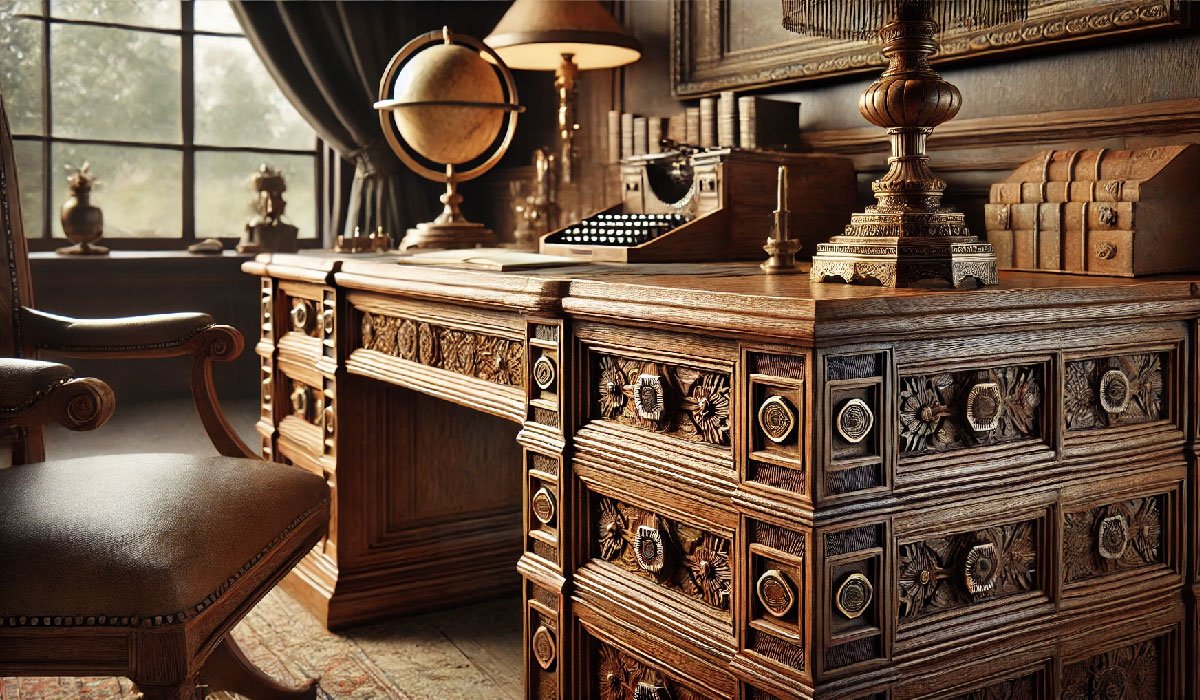Have you ever wondered why collectors and furniture enthusiasts cherish antique desks with such passion? Among the myriad of vintage furnishings, the Antique Faux Quarter Sawn Oak Desk with Square Nuts stands out as a particularly sought-after piece. In this article, we will delve deep into the world of these antique desks, exploring their beauty, craftsmanship, and enduring appeal. From the distinctive materials used to their functional elegance and historical significance, this piece is not merely furniture—it’s a slice of history.
What is an Antique Faux Quarter Sawn Oak Desk With Square Nuts?
Antique Faux Quarter Sawn Oak Desks with Square Nuts are remarkable pieces of furniture that beautifully blend craftsmanship and heritage. The term “faux quarter sawn oak” refers to a woodworking technique that emulates the appearance of quarter sawn oak—a method where the log is cut at a 90-degree angle to the growth rings. This technique produces a distinctive grain pattern that is highly valued for its aesthetic and structural qualities.
Unlike genuine quarter sawn oak, which can be expensive and rare, faux quarter sawn oak offers a more accessible alternative without compromising the visual allure. Historically, these desks originated in the late 19th and early 20th centuries, a period marked by a robust appreciation for durable and ornate wood furniture.
The Craftsmanship of Antique Faux Quarter Sawn Oak Desks
Materials and Manufacturing
The creation of an Antique Faux Quarter Sawn Oak Desk involves meticulous craftsmanship. The wood, chosen for its durability and grain texture, undergoes a specialized cutting process to simulate the quarter sawn look. Square nuts, made typically of iron or steel, are then used to assemble and secure the desk components. These nuts not only enhance the structural integrity of the desk but also add an element of rustic charm.
Artistic Details
Every Antique Faux Quarter Sawn Oak Desk is a testament to the artisan’s skill, often featuring intricate carvings, dovetail joints, and a hand-finished patina that accentuates the wood’s natural beauty. The desks might also include additional ornamental features such as brass drawer handles or carved panels, each adding to the unique character of the piece.
Aesthetic and Design Features
Visual Appeal and Design Elements
The visual appeal of these desks is undeniable. The faux quarter sawn technique produces a wood grain that is both visually striking and uniformly beautiful, ensuring that each desk has a unique but cohesive appearance. The incorporation of square nuts not only serves a practical purpose but also contributes to the aesthetic, offering a contrast of metal against wood that is visually pleasing and historically authentic.
Style Integration
Despite their antique origins, these desks integrate seamlessly into various interior design styles. Whether it’s the centerpiece of a traditional study or a distinctive addition to a modern living space, the Antique Faux Quarter Sawn Oak Desk with Square Nuts adapts to its surroundings while maintaining its standout charm.
Historical Importance and Usage
From Past to Present
Originally, these desks served as focal points in Victorian-era offices and homes, designed for both durability and style. Over time, their purpose has expanded from mere functional workspaces to include roles as statement pieces in homes and collections. The evolution of their design reflects changes in aesthetic preferences and advances in woodworking technology, making each desk a historical snapshot of its time.
Collecting Antique Faux Quarter Sawn Oak Desks
Market Trends and Value Assessment
In the realm of antique furniture collecting, these desks are highly prized for their craftsmanship, age, and patina that only time can bestow. Collectors and investors alike seek out these pieces not only for their beauty but also for their potential to increase in value. When assessing a desk’s worth, factors such as condition, authenticity, and provenance play crucial roles.
Buying Tips
For potential buyers, it’s important to look for signs of originality such as tool marks, wear consistent with age, and original hardware. It’s also advisable to purchase from reputable dealers or auction houses that can provide detailed histories of the pieces.
Care and Maintenance

Preserving Your Desk
Maintaining an Antique Faux Quarter Sawn Oak Desk requires careful attention. Regular dusting, avoiding direct sunlight, and controlling humidity levels are key to preserving the wood’s condition. For metal components like square nuts, periodic checking, and tightening can prevent structural issues while maintaining the original character of the desk.
Read Also: Comprehensive Review of the London Fog LFF22900-CRCE Purse: Elegance Meets Practicality
The Role of Square Nuts in Functionality and Design
Technical and Aesthetic Contributions
Square nuts, beyond their functional role in assembly, are a nod to the industrial era’s design ethos, where durability met design in everyday objects. Their robust form complements the wood’s natural toughness, while their visible placement can enhance the desk’s industrial aesthetic.
Faux Quarter Sawn Oak vs. Genuine Quarter Sawn Oak
Comparative Analysis
While faux quarter sawn oak mimics the straight grain pattern of its genuine counterpart, there are differences in grain depth and shimmer that can affect both appearance and wear. However, faux quarter sawn offers a more sustainable and affordable alternative, providing similar aesthetic appeal without the high cost associated with genuine quarter sawn oak.
Incorporating Antique Desks into Modern Interiors

Design Tips and Versatility
These desks can serve as focal points in any room, bridging the gap between antique and contemporary styles. They work well in diverse settings, from classic offices to eclectic living rooms, bringing a sense of history and sophistication to modern interiors.
Conclusion: Preserving a Legacy
The Antique Faux Quarter Sawn Oak Desk with Square Nuts is more than just furniture; it’s a piece of history that embodies the art of traditional craftsmanship. With its rich textures, intricate details, and robust construction, this desk remains a beloved artifact that continues to inspire and fascinate. By preserving and integrating these timeless pieces into our lives, we keep the legacy of vintage craftsmanship alive for future generations to appreciate and enjoy. Whether for practical use or aesthetic admiration, owning one of these desks connects us to a past era of artful furniture making, making it a worthwhile investment for any collector or enthusiast.
(FAQs): Antique Faux Quarter Sawn Oak Desk with Square Nuts
What is a faux quarter sawn oak technique?
Faux quarter sawn oak refers to a method of cutting and treating wood so that it imitates the appearance of quarter-sawn oak. This involves creating a similar grain pattern that is typically seen in true quarter-sawn oak, which is known for its durability and distinctive ray flecks.
Why are square nuts used in antique desks?
Square nuts were commonly used in furniture making during the late 19th and early 20th centuries because they provided a strong, durable method of fastening that was aesthetically pleasing in its time. In antique faux quarter sawn oak desks, these nuts not only enhance the structural integrity but also add to the vintage charm of the piece.
How can I identify an authentic antique faux quarter sawn oak desk with square nuts?
To identify an authentic piece, look for characteristics such as:
- Grain Pattern: The wood should exhibit the distinctive straight or slightly wavy grain pattern typical of quarter sawn oak.
- Square Nuts: Genuine antique desks will have square nuts that are consistent with the period’s hardware style.
- Wear and Patina: Authentic antique furniture will show signs of wear and a natural patina that develops over many years.
- Craftsmanship Details: Check for handcrafted joints and finishes, which are indicative of older, more traditional methods of furniture construction.
Where can I find an antique faux quarter sawn oak desk with square nuts?
These desks can be found at antique stores, online auctions, estate sales, and specialty shops that deal in vintage furniture. When searching online, platforms like eBay, Etsy, and Ruby Lane are good places to start.
How do I care for an antique faux quarter sawn oak desk?
Caring for an antique desk involves:
- Avoiding excessive sunlight and moisture: Both can cause the wood to warp or the finish to degrade.
- Regular dusting: Use a soft, dry cloth to keep the surface free of dust and debris.
- Polishing: Use a suitable wood polish to enhance the wood’s natural luster without damaging the finish.
- Tightening the square nuts: Check and tighten the square nuts periodically to ensure they are secure, but be cautious to avoid stripping the metal.
Can an antique faux quarter sawn oak desk with square nuts fit into modern interior decor?
Yes, these desks can seamlessly integrate into modern interiors due to their timeless design and robust construction. They work well as focal points in a room or can be used in a more functional capacity in home offices, blending with both contemporary and traditional decor styles.
Are antique faux quarter sawn oak desks with square nuts a good investment?
Antique furniture can be a good investment if chosen wisely. Desks made with the faux quarter sawn technique that are in good condition and have historical significance can appreciate in value over time, especially if well-maintained and authenticated.



